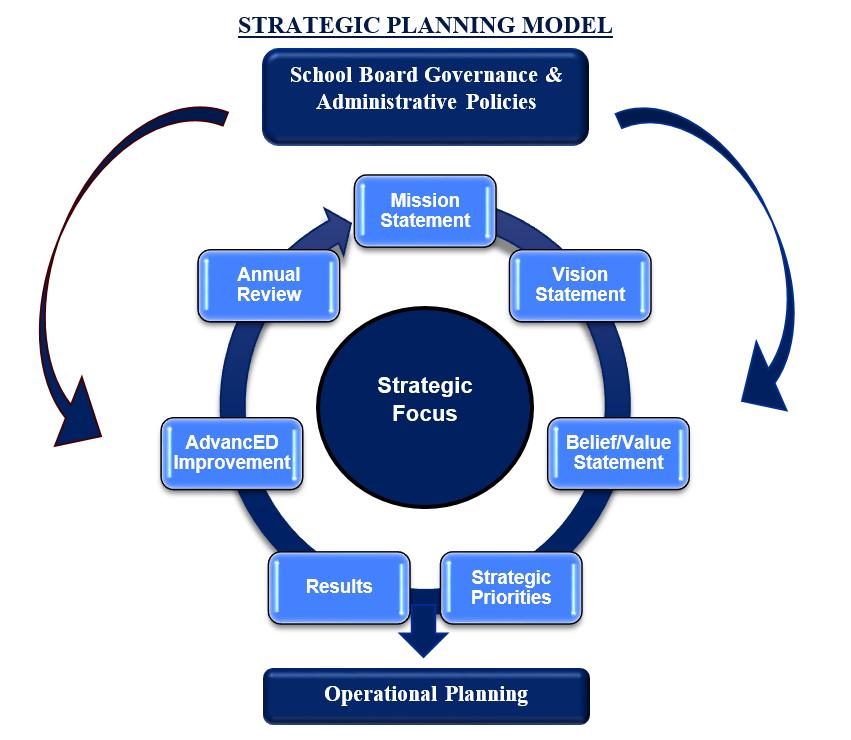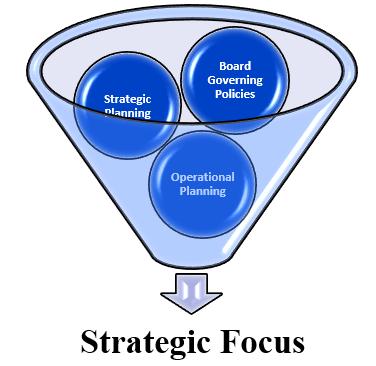STRATEGIC PLANNING PROCESS
OVERVIEW AND DEFINITIONS
School District Systems Alignment
There is a difference between the three central tenets of school district organization. Those tenants include Board Governance Policies, District Strategic Planning, and District Operational Planning. The following definitions help clarify the roles each plays in a strategically aligned school district. See figure below:
Elements of a Strategic Plan
A comprehensive strategic plan includes both the academic and operational aspects of a school district as identified in the district's accreditation process; the AdvancED school improvement model. This model consists of three domains:
- Leadership Capacity
- Learning Capacity
- Resource Capacity
The Domains are statements that define the capacity of a school district to provide quality student experiences as measured by a set of standards and meet the rigorous demands of continuous school district improvement. A Strategic Plan will align the work of the District in both academic and operational strategic initiatives, goals, and result metrics.
The elements of a good strategic plan include: Mission Statement, Vision Statement, Belief or Value Statements, Strategic Initiatives, Goals, and Results and are aligned with the AdvancED performance standards for continuous school improvement.
What is Strategic Planning?
Strategic planning is an organizational management activity that is used to set priorities, focus energy and resources, strengthen operations, and ensure that employees, board members, and stakeholders are all working toward common goals. It is an effort that will guide fundamental decisions and actions to shape the future of your school district.
What is a Strategic Plan?
A Strategic Plan is a living document used to communicate the organization's goals, the priorities needed to achieve those goals, and metrics used to measure progress on those goals. It includes both the academic and operational aspects of the school district.
Strategic plans are aligned with the Boards governing policies. Through these policies, the Board sets the directive; however, the Superintendent ensures a process is put in place to develop and implement a strategic plan.
Strategic Planning vs. Operational Planning
A strategic plan is a living document used to communicate the organization's goals, the priorities needed to achieve those goals, and metrics used to measure progress on those goals. It outlines your mission, vision, values, and strategic initiatives (focus) for the next three to five years. A focused strategic plan will strengthen operations, and ensure that employees, board members, and stakeholders are all working toward common goals.
An operational plan is a yearly plan which will focus the work of the district during the current school year. It is the mechanism used to implement a strategic plan. The operational plan is directly aligned to the strategic plan and includes metrics to measure.
Environmental Scanning
Engaging in a strategic planning process involves looking at the internal and external factors both perceptual and factual associated with the school district's current performance. A method typically used to complete this task is called "Environmental Scanning".
Environmental scanning is a process where both internal and external factors that impact the effectiveness of a school district are examined. The method identifies the strengths and challenges facing the school district.
-
Current strategic and operational plans
-
District policies which pertain to operational practices
-
AdvancED Reports
-
ND Insights review - DPI dashboard
-
Internal academic measurements and metrics
-
District demographic trends
-
Review of current district initiative
SWOT Analysis
In addition to the review of these documents, the Strategic Planning Committee engaged in a SWOT Analysis activity. A SWOT Analysis is a process where both internal and external factors that impact the effectiveness of a school district/organization are examined. Strengths, weaknesses, opportunities, and threats analysis (SWOT Analysis) can assist in identifying these factors. A summary of the SWOT Analysis activity can be found in Addendum 1.

Quick Links
Upcoming Events
This site provides information using PDF, visit this link to download the Adobe Acrobat Reader DC software.

